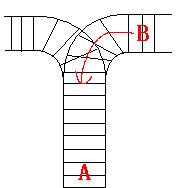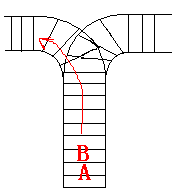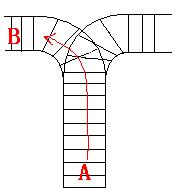The input contains several test cases. Each test case consists of an integer, the number of trains, and two strings, the order of the trains come in:O1, and the order of the trains leave:O2. The input is terminated by the end of file. More details in the Sample Input.
The output contains a string "No." if you can‘t exchange O2 to O1, or you should output a line contains "Yes.", and then output your way in exchanging the order(you should output "in" for a train getting into the railway, and "out" for a train getting out of the railway). Print a line contains "FINISH" after each test case. More details in the Sample Output.
Yes.
in
in
in
out
out
out
FINISH
No.
FINISH
For the first Sample Input, we let train 1 get in, then train 2 and train 3.
So now train 3 is at the top of the railway, so train 3 can leave first, then train 2 and train 1.
In the second Sample input, we should let train 3 leave first, so we have to let train 1 get in, then train 2 and train 3.
Now we can let train 3 leave.
But after that we can‘t let train 1 leave before train 2, because train 2 is at the top of the railway at the moment.
So we output "No.".
We have carefully selected several similar problems for you:
1026 1023 1020 1032 1001 此题不真正的仔细读难理解出事栈的应用,容易想成反序相等就yes的问题,此题题意是说输入的两列字符串,第一列表示进入的顺序,第二列表示出去的顺序,问你是否符合后进先出。
举出一列数据 7 1234567 4321576
上面数据应该是 in in in in out out out out in out in in out out;
所以不是反序才行 可以进到一半就出的
#include<bits/stdc++.h>
using namespace std;
typedef long long LL;
int main()
{
int n,i,j;
string str1,str2;
while(cin>>n>>str1>>str2)
{
stack<char> s;
vector<string> v;
for( i=0,j=0;i<n&&j<n;i++)
{
s.push(str1[i]);//元素进栈
v.push_back("in");//字符压进容器
while(s.top()==str2[j])//匹配
{
if(!s.empty())
{
s.pop();
v.push_back("out");
}
j++;
if(s.empty())
break;
}
}
if(j==n)//判断依据
{
printf("Yes.\n");
for(i=0;i<v.size();i++)
cout<<v[i]<<endl;
cout<<"FINISH"<<endl;
}else
{
cout<<"No."<<endl<<"FINISH"<<endl;
}
}
return 0;
}


